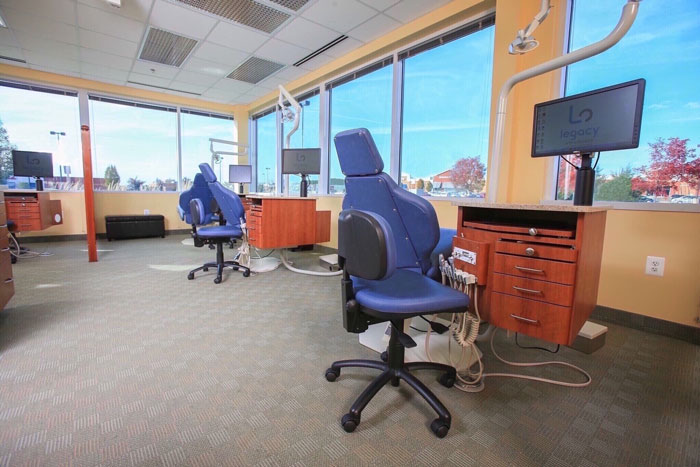The Buzz on Legacy Orthodontics
The Buzz on Legacy Orthodontics
Blog Article
Indicators on Legacy Orthodontics You Should Know
Table of ContentsThe Main Principles Of Legacy Orthodontics Legacy Orthodontics Fundamentals ExplainedThe Main Principles Of Legacy Orthodontics The Only Guide for Legacy OrthodonticsGetting The Legacy Orthodontics To Work
In addition, we supply flexible therapy schedules, adaptable repayment choices and an enjoyable, satisfying experience.An orthodontist is a dental practitioner educated to detect, avoid, and treat teeth and jaw abnormalities. Orthodontists work with people of all ages, from kids to grownups.
Malocclusion, or misaligned teeth, can result in dental issues, consisting of tooth degeneration, gum condition, and tough or agonizing eating. Yet not everyone is born with straight teeth. If you have a bad bite or big rooms in between your teeth, you may desire to seek advice from a dental professional concentrating on orthodontic care.
The Best Strategy To Use For Legacy Orthodontics
( Picture Credit Scores: DigitalVision/Getty Images) Orthodontists use taken care of and removable dental gadgets, like dental braces, retainers, and bands, to change the placement of teeth in your mouth. Orthodontic therapy is for oral problems, including: Crooked teethBite problems, like an overbite or an underbiteCrowded teeth or teeth that are also far apartJaw misalignmentThe goal of orthodontic therapy is to boost your bite.
While you may assume of orthodontists as mainly for children or teenagers that need dental braces, they can fix dental problems at any type of age. Orthodontists go to university, dental institution, and orthodontic college.
, but not all dental professionals are orthodontists. They concentrate on two areas: Exactly how to correctly and securely move teeth Exactly how to appropriately lead advancement in the teeth, jaw, and faceOnce an orthodontist has actually completed training, they have the option to become board accredited.
Legacy Orthodontics Can Be Fun For Everyone
Misalignment, or malocclusion, is one of the most usual reason individuals see an orthodontist. It is genetic and is the result of dimension distinctions between the top and lower jaw or in between the jaw and teeth. Malocclusion results in tooth congestion, a twisted jaw, or irregular bite patterns. Malocclusion is generally treated with: Your orthodontist connects metal, ceramic, or plastic square bonds to your teeth.
If you have just small malocclusion, you may have the ability to make use of clear braces, called aligners, as opposed to conventional dental braces (https://www.magcloud.com/user/legacyortho). Some individuals require a headgear to help relocate teeth right into line with pressure from outside the mouth. After dental braces or aligners, you'll need to put on a retainer. A retainer is a custom gadget that keeps your teeth in position.
They can develop added area in the mouth without having to draw teeth. Orthodontists use cords, medical screws, or plates to support your jaw bone.
You might need to see an orthodontist if you have: Crowding or not adequate space for all of your teethOverbite, when your top teeth come your base teethUnderbite, when your bottom teeth are as well far forwardSpacing or problems with gapsCrossbite, which is when your upper teeth fit behind your base teeth when your mouth is closedOpen bite or a vertical void in between your front bottom and top teethMisplaced midline, when the facility of your base and upper teeth do not align Correcting a dental malocclusion can: Make attacking, chewing, and speaking easierImprove the balance of our face and your overall appearanceEase discomfort from temporomandibular joint problemsDifferent your teeth and make them much easier to cleanse, helping prevent dental caries or dental caries It's frequently a dental expert that first notices misaligned teeth throughout a regular exam.
How Legacy Orthodontics can Save You Time, Stress, and Money.

Throughout your initial orthodontic assessment, you'll likely have: A dental examPhotos taken of your face and smileDental X-raysPanoramic (360 degree) X-rays of your face and headImpressions to create mold and mildews of your teethThese tests will certainly help your orthodontist understand exactly how to wage your treatment. invisalign. An orthodontist is a dental practitioner that's had training to treat your teeth and jaw
An orthodontist is concentrated on your bite, so something like a chipped tooth would be taken care of by a dental practitioner. Orthodontists are focused on your bite, or the method your teeth fit together, and the straightness of your teeth.
Ever asked yourself exactly how celebs always seem to have flawlessly lined up teeth? Orthodontists are dental specialists that concentrate on remedying abnormalities in the teeth and jaws.
The Ultimate Guide To Legacy Orthodontics

While braces are one of the most generally acknowledged orthodontic treatment, orthodontists have a diverse toolkit at their disposal. The details strategy chosen depends upon the seriousness of the case, the client's age, and private choices. These tried-and-true dental braces make use of a system of brackets adhered to the teeth and connected by wires.
Clear aligners, like Invisalign, are a prominent alternative for individuals looking for a more very discreet therapy choice. These detachable trays are tailor-made to progressively move the teeth's setting. Headwear may be made use of in conjunction with braces or aligners to use additional targeted forces, specifically for remedying jaw discrepancies. In situations of slim jaws, palatal expanders can be a knockout post used to develop space for appropriate tooth alignment.
Report this page